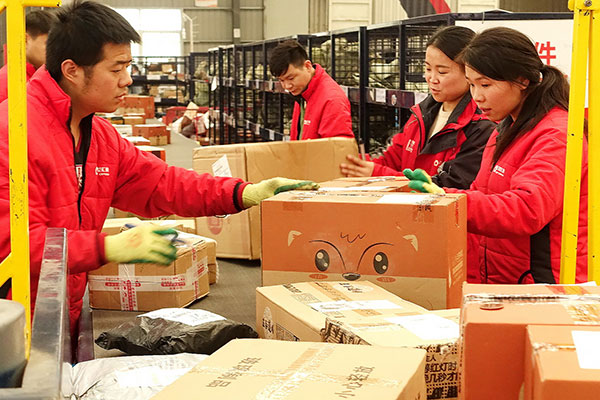
Workers sort packages after an online shopping spree in November in Fuyang, Anhui province.[Photo/China Daily]
E-commerce powerhouses in China are extremely bullish about strengthening trade ties and invigorating economic activities in economies along the Belt and Road Initiative, industry observers said.
They said that as fast-growing mobile and internet usage propels consumer spending, an ever-widening array of “Made in China” items will be at their fingertips, while Chinese bring home worldwide delicacies thanks to frictionless online transactions and fast cross-border deliveries.
Chinese phones are gaining traction among buyers notably in Eastern Europe and the Middle East, with Russia, Ukraine and Israel topping the list of generous spenders on these gadgets, according to AliResearch, the research arm of Alibaba Group Holding Ltd.
Apart from electronic devices, fashion and jewelry, women’s apparel and nail beauty accessories are the latest darling of foreign buyers, said the report, which tracked data from AliExpress, Alibaba’s international marketplace that has served more than 100 million overseas shoppers.
Bargain hunters in Russia have pushed the e-commerce boom to new heights, with Chinese products including phones, clothing and other consumer electronics being the most popular items.
The cyber Silk Road, which effectively links smaller merchants with individual customers, is fueling new momentum to the Belt and Road Initiative by promoting inclusive trade and access to logistics and financial services once reserved mainly for multinationals, said Gao Hongbing, Alibaba’s vice-president.
“This relatively new and frictionless method of conducting business on the digital platform can enable more businesses and entrepreneurs to participate in global trade and reap the benefits of globalization,” Gao said.
Meanwhile, businesses along the Belt and Road routes have found early success via online channels as Chinese purchasing power explodes. For instance, nearly 280,000 latex pillows from Thailand were sold last year via Tmall Global, a site sourcing imported goods to Chinese customers.
Likewise, thousands of brands have established a prominent presence and reaped huge gains as Chinese customers snap up instant coffee and tea bags from Malaysia, carpets from India and date palms from the United Arab Emirates.
The cross-border marketplace on JD.com Inc, the nation’s second-largest e-commerce player, covers 70 countries and regions and is poised to partner with more Asian and Central European vendors, said Qi Ting, general-manager of JD Worldwide.
Leveraging the China-Europe rail network, a crucial part of the initiative, JD has halved the time to transport auto supplies from Germany to southwestern China compared with sea routes, she said.
“The internet is the key feature of the Belt and Road Initiative in the 21st century, and cooperation in internet-related services along the routes propels innovation and industrial upgrading,” said Wang Yiwei, director of the Institute of International Affairs at Renmin University of China in Beijing.
